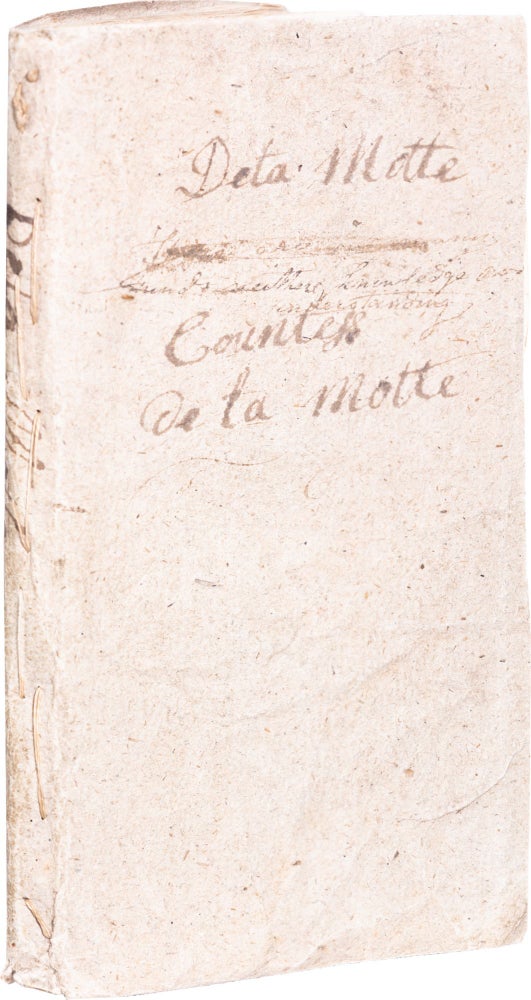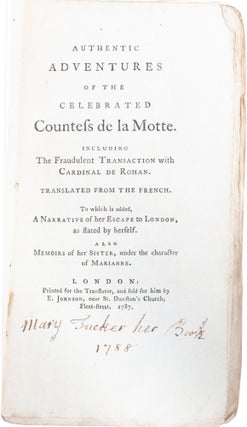Authentic Adventures of the Celebrated Countess de la Motte
London: J. Johnson, 1787. First Edition. Wrappers. 1st edition (in English, though quickly translated into French), preceding all other accounts of the sensational story, believed by many on the ground at the time, to have been the prime catalyst for The French Revolution, but whether it was all that or not, it was certainly the most successful use of a book for propaganda until Harriet Stowe’s Uncle Tom’s Cabin in 1852. Original wrappers, title, author, etc. written on the wraps else a fine, complete, untouched copy (see photograph) rare in this amazing state of condition, but rare only in this condition. Fine. Item #348
Here’s what happened. In 1772, the grand necklace was designed by the Parisian jewelers Boehmer and Bassenge in response to a request from King Louis XV that it exceed any other necklace extant. Louis planned to gift it to his mistress Madame du Barry, despite the price of 2 million livres (14 million dollars today), but in May 1774, while the necklace was being assembled, Louis XV died of smallpox and his heir, Louis XVI, banished du Barry from court. Boehmer and Bassenge tendered the necklace to the new king, and he offered it as a gift to his wife, Queen Marie Antoinette, who refused it, not wanting something made for another woman, especially a courtesan she disliked. The jewelers tried to place the necklace outside of France but the market was thinner than butter spread on bread, the effort failed, and fearing bankruptcy, Boehmer and Bassenge fell into a despondent anxiety. Enter Comtesse Jeanne de la Motte, a married grifter with a preposterous scheme whispered to her in outline by Giuseppe (Joseph) Balsamo, residing in Paris in disguise under the alias Count Alessandro di Cagliostro. Balsamo was the founder of the Masonic mother lodge “The Triumphant Wisdom of the Egyptian Freemasonry” at Lyon and the head of an unnamed international secret society already plotting the French revolution. De la Motte first seduced the Cardinal Louis de Rohan, a man of great wealth but out of Royal favor and desperate to regain it. While still Rohan’s mistress, she wedged herself into the Royal Court at Versailles as the concurrent mistress of Rétaux de Villette, an officer in the gendarmerie with a position at court. She then forged a conspiracy with her husband and Villette, and convinced Rohan she had the Queen’s ear, and that, through her, he could regain the Queen’s favor. With this lie in place, she launched an alleged, but forged, secret correspondence between the gullible Rohan and the unknowing Queen, which convinced Rohan that the Queen was in love with him. This led to a clandestine meeting, on a dark night, in a Versailles garden, between Rohan and a prostitute hired by de la Motte who happened to resemble the Queen. With Rohan fully duped, de la Motte approached the jewelers and arranged a commission for herself if she could place the necklace. A counterfeit letter to Rohan from the Queen followed, asking Rohan to buy her the necklace for which she would repay him. Now Cardinal Rohan was rich but he wasn’t that rich, so after emptying his bank for a substantial deposit, the necklace was given to La Motte who said she would deliver it to Marie Antoinette. Instead she gave it to her husband who sailed to London, broke up the necklace, and began selling the diamonds individually. The affair came to light when Rohan missed his payment schedule, and the Cardinal, Comtesse de la Motte, Rétaux de Villette, and Nicole d’Oliva (the prostitute who resembled the Queen) were all arrested. Also arrested was Count Cagliostro (his alias unveiled), who had participated in the affair as plotter and instigator. The King, unwisely, demanded a public trial to defend his honor, but it had the opposite effect as the public, inflamed with disinformation spread by Cagliostro’s agents, came to believe the Queen to be both greedy and guilty. The Cardinal was acquitted as a dupe, but exiled. Nicole d’Oliva was acquitted as an unknowing hired entertainer. Rétaux de Villette was found guilty of forgery and exiled. Cagliostro was acquitted but exiled. As for Jeanne de la Motte, she was judged guilty and condemned to prison for life. She managed to escape disguised as a boy (to the joy of the public), and fled to London where she rejoined her husband and wrote this book, that justified her actions and cast the blame on her primary victim, Marie Antoinette. The French people believed her account, anger heated, and then boiled over 2 years later when the Bastille was stormed and the French Revolution was lit. 2 years after that de la Motte was assassinated (probably by The Maison Rouge), beaten to death in a London hotel and pushed from a high window so as to cloak the assault as an accidental fall or suicide. 2 years after that, Queen Marie Antoinette was guillotined while someone sang La Marseillaise.
Price:
$6,000.00


